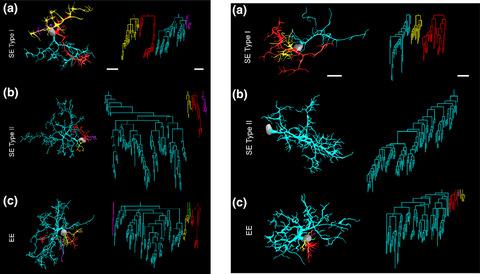当前位置:
X-MOL 学术
›
Eur. J. Neurosci.
›
论文详情
Our official English website, www.x-mol.net, welcomes your feedback! (Note: you will need to create a separate account there.)
Long‐term environmental enrichment reduces microglia morphological diversity of the molecular layer of dentate gyrus
European Journal of Neuroscience ( IF 3.698 ) Pub Date : 2020-07-29 , DOI: 10.1111/ejn.14920 Thaís Cristina Galdino de Oliveira 1 , Dario Carvalho‐Paulo 1 , Camila Mendes de Lima 1 , Roseane Borner de Oliveira 1 , Carlos Santos Filho 1 , Daniel Guerreiro Diniz 1, 2 , João Bento Torres Neto 1 , Cristovam Wanderley Picanço‐Diniz 1
European Journal of Neuroscience ( IF 3.698 ) Pub Date : 2020-07-29 , DOI: 10.1111/ejn.14920 Thaís Cristina Galdino de Oliveira 1 , Dario Carvalho‐Paulo 1 , Camila Mendes de Lima 1 , Roseane Borner de Oliveira 1 , Carlos Santos Filho 1 , Daniel Guerreiro Diniz 1, 2 , João Bento Torres Neto 1 , Cristovam Wanderley Picanço‐Diniz 1
Affiliation

|
We investigated long‐term environmental influences on morphology of microglia from the outer and middle thirds of molecular layer of the dentate gyrus (MolDG), and on microglia from dorsal and ventral dentate gyrus molecular layer. We also estimated the total number of MolDG microglia using stereology. For this purpose, microglia of the molecular layer of the dentate gyrus of 20‐month‐old female Swiss albino mice, housed from 21st postnatal day onwards, in the impoverished environment of the standard laboratory cages (SEA), or in a cage with an enriched environment (EEA), were reconstructed microscopically in three dimensions and compared with each other and with microglia of 6‐month‐old female Swiss albino mice, also housed from weaning onwards in an enriched cage (EEY). All mice had their brains sectioned and processed for immunolabeling for IBA‐1, a selective microglia marker. Random and systematic microglia samples were reconstructed in three dimensions and classified morphologically using hierarchical cluster analysis, followed by discriminant function analysis. SEA and EEY showed two morphological phenotypes of microglia in both the outer and middle thirds of MolDG. EEA mice showed such a reduction in the morphological diversity of microglia that essentially a single morphotype was found. EEA mouse microglia showed an intermediate morphological complexity between types I and II SE microglia. We suggest that type I and type II microglia in SE mice may have different physiological roles and that long‐term EE may be associated with adaptive responses of microglial phenotypes to somatomotor and cognitive stimuli.
中文翻译:

长期环境富集减少了齿状回分子层的小胶质细胞形态多样性
我们调查了长期环境对齿状回(MolDG)分子层的外层和中间三层对小胶质细胞形态的影响,以及对背侧和腹侧齿状回分子层的小胶质细胞的影响。我们还使用立体学估计了MolDG小胶质细胞的总数。为此,将20个月大的雌性瑞士白化病小鼠的齿状回分子层的小胶质细胞从出生后第21天开始,在标准实验室笼(SEA)贫瘠的环境中,或在带有成虫的笼中饲养。在三个维度上用显微镜重建了富集环境(EEA),并将它们与6个月大的雌性瑞士白化病小鼠的小胶质细胞进行了比较,这些小鼠也从断奶后开始饲养在富集笼(EEY)中。将所有小鼠的大脑切开并进行处理,以进行IBA-1(一种选择性小胶质细胞标记物)的免疫标记。随机和系统的小胶质细胞样本在三个维度上重建,并使用层次聚类分析,然后进行判别函数分析,进行形态分类。SEA和EEY在MolDG的外部和中间三分之二中都显示出两种小胶质细胞的形态表型。EEA小鼠表现出小胶质细胞形态多样性的降低,以至于基本上只发现了一种形态型。EEA小鼠小胶质细胞在I型和II型SE小胶质细胞之间表现出中等的形态复杂性。我们建议SE小鼠中的I型和II型小胶质细胞可能具有不同的生理作用,长期EE可能与小胶质细胞表型对躯体运动和认知刺激的适应性反应有关。
更新日期:2020-07-29
中文翻译:

长期环境富集减少了齿状回分子层的小胶质细胞形态多样性
我们调查了长期环境对齿状回(MolDG)分子层的外层和中间三层对小胶质细胞形态的影响,以及对背侧和腹侧齿状回分子层的小胶质细胞的影响。我们还使用立体学估计了MolDG小胶质细胞的总数。为此,将20个月大的雌性瑞士白化病小鼠的齿状回分子层的小胶质细胞从出生后第21天开始,在标准实验室笼(SEA)贫瘠的环境中,或在带有成虫的笼中饲养。在三个维度上用显微镜重建了富集环境(EEA),并将它们与6个月大的雌性瑞士白化病小鼠的小胶质细胞进行了比较,这些小鼠也从断奶后开始饲养在富集笼(EEY)中。将所有小鼠的大脑切开并进行处理,以进行IBA-1(一种选择性小胶质细胞标记物)的免疫标记。随机和系统的小胶质细胞样本在三个维度上重建,并使用层次聚类分析,然后进行判别函数分析,进行形态分类。SEA和EEY在MolDG的外部和中间三分之二中都显示出两种小胶质细胞的形态表型。EEA小鼠表现出小胶质细胞形态多样性的降低,以至于基本上只发现了一种形态型。EEA小鼠小胶质细胞在I型和II型SE小胶质细胞之间表现出中等的形态复杂性。我们建议SE小鼠中的I型和II型小胶质细胞可能具有不同的生理作用,长期EE可能与小胶质细胞表型对躯体运动和认知刺激的适应性反应有关。


























 京公网安备 11010802027423号
京公网安备 11010802027423号